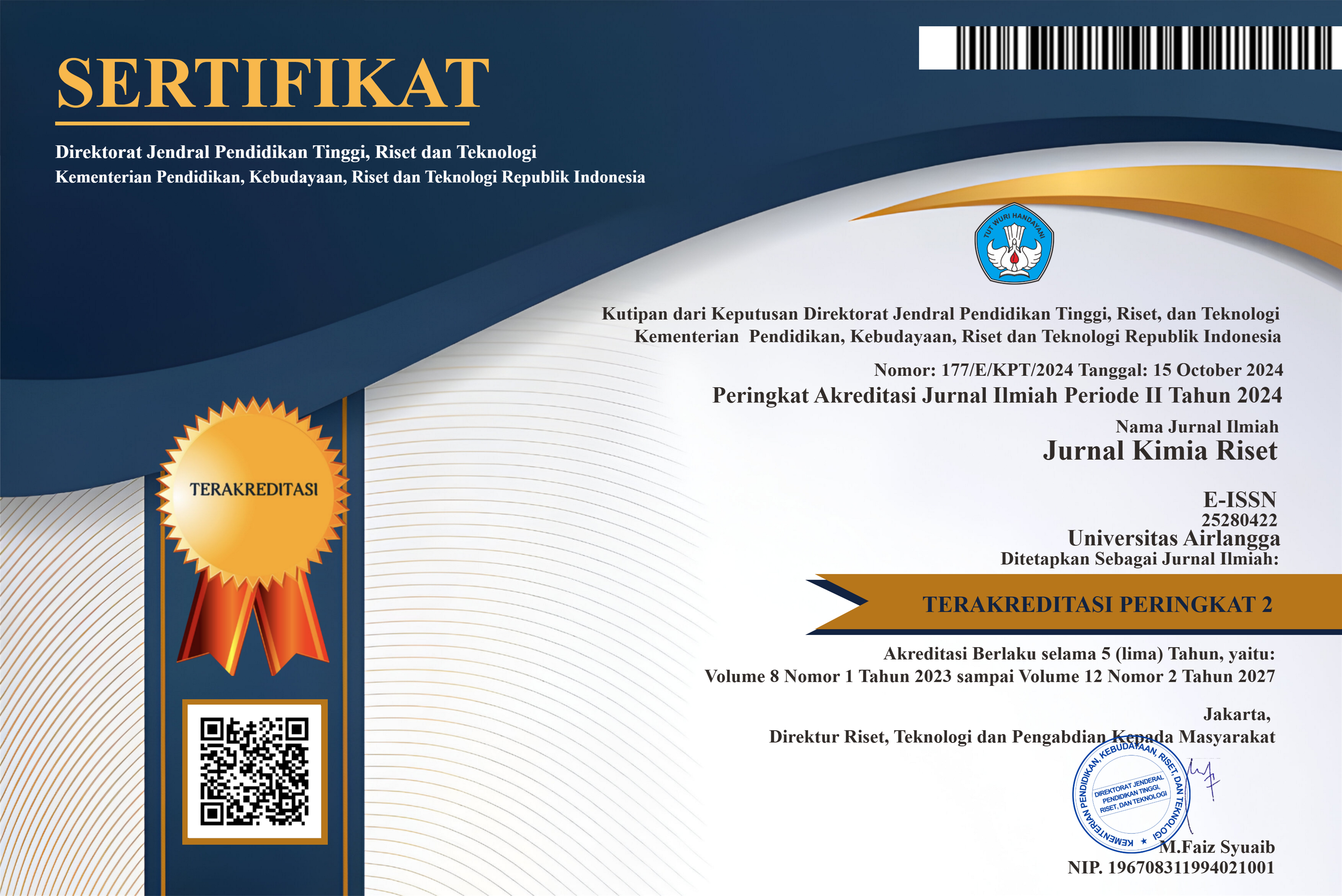UJI POTENSI ANTIJAMUR CANDIDA ALBICANS EKSTRAK DAUN GELINGGANG (CASSIA ALATA L.) DIBANDINGKAN DENGAN SEDIAAN DAUN SIRIH YANG BEREDAR DI PASARAN SECARA IN VITRO
Downloads
ABSTRAK
Candida albicansmerupakan salah satu contoh mikroorganisme patogenik penyebab infeksi pada bagianlumenorgan tubuh manusia yang berbentuk saluran. Candida albicanspada saluran reproduksi dan saluran urinaria wanita sering dikenal dengan "penyakit keputihan”. Salah satu cara mengatasi munculnya keputihan adalah dengan membersihkan daerah kewanitaan menggunakan larutan antiseptik seperti povidone iodine. Masyarakat pada umumnya juga menggunakan sediaan daun sirih yang telah beredar di pasaran. Sediaan ini juga dikenal sebagai antiseptik sehingga dapat menghambat pertumbuhan C. Albicans,selain daun sirih (Piper bitleL.), ternyata daun gelinggang atau ketepeng cina (Cassia alataL.) juga memiliki aktivitas antibakteri dan antijamur.
Penelitian ini merupakan penelitian eksperimental dengan menggunakan isolat jamur C.albicans. Proses ekstraksi daun gelinggang dilakukan dengan teknik maserasi menggunakan pelarut metanol, alkohol 96%, dietil eter, dan infusa. Ekstrak dan SDS diuji aktivitas antijamurnya dengan menggunakan metode difusi agar menggunakan kertas cakram. Analisis uji ini dilakukan dengan mengukur zona hambatan ekstrak dan sediaan daun sirih terhadap pertumbuhan jamur.
Analisis nilai persentase aktivitas zona hambat ekstrak metanol daun C.alata menunjukkan tidak adanya perbedaan yang signifikan dengan SDS 1 (asymp. Sig.= 0,245) dan dengan SDS 2 (asymp. Sig. = 0,882) dalam menghambat pertumbuhan jamurC.albicans.Ekstrak metanol daun gelinggang memiliki efektifitas yang hampir sama dengan dua kelompok perlakuan SDS yang beredar di pasaran(SDS 1 dan SDS 2).
Kata kunci: Antijamur, Candida albicans, sediaan daun sirih (SDS), ekstrak daun Gelinggang (Cassia alata L.).
ABSTRACT
Candida albicans is one of pathogenic microorganisms that cause infections in the lumen of the organs of human body in the shape of the channel. Candida albicans in the reproductive tract and women urunaria tract is often known as "diseases of vaginal discharge". One way of overcoming the appearance of vaginal discharge is to clean the area using an antiseptic solution of femininity such as povidone iodine. Society in General also use material of betel leaf that has been circulating in the market. This material is also known as an antiseptic so that it can inhibit the growth of C. albicans. In addition to the betel leaf (Piper bitle l.), turns the leaves gelinggang or Chinese ketepeng (Cassia alata L.) also has antibacterial and antifungal activity.
The objective of this study was to compare the test potential antifungal Candida albicans gelinggang leaves (Cassia alata L.) with material of betel leaf that already circulating in the market(SDS).This research is experimental research using fungal isolates of C. albicans. The extraction process of leaf gelinggang done with the technique of maceration using methanol solvent, 96% alcohol, diethyl ether, and infusa. Extract and SDS tested of antifungal activity by using diffusion method using paper discs. The analysis of the test is done by measuring the resistance zone extracts and preparations betel leaf against mold growth.
The analysis of the value of the percentage of the activity of the methanol extracts of the leaves of the inhibitory zones c. alata indicates the absence of a significant difference with the SDS 1 (asymp. Sig. = 0.245) and with SDS 2 (asymp. Sig. = 0.882) in inhibiting the growth of c. albicans yeast.The methanol extract of gelinggang leaves treatment has effectiveness similar to the treatment of the two groups of SDS (SDS 1 and SDS 2) that is circulating in the market.
Keywords: Antifungal preparations, Candida albicans, Betel leaf (SDS), Gelinggang leaf extract (Cassia alata L.).Zubier F, Bramono K, Widaty S, Nilasari H, LouisaM, Rosana Y. Efikasi sabun ekstrak sirih merah dalam mengurangi gejala keputihan fisiologis. Majalah Kedokteran Indonesia. 2010; 60(1).
Hawkins, Bourne. Text book of gynaecology. Edisi ke-15. USA: Elsevier Publication; 2011.
Berek JS, Berek, Novak. Gynecology. Edisi ke-14. USA: Lippincott Williams & Wilkins Publishers; 2007.
Wijayanti RE, Hardjito K, Yuliati S. Gambaran cara-cara penanganan keputihan yang dilakukan oleh remaja putri usia 16-18 tahun di MAN 3 Kediri. Jurnal Penelitian Kesehatan Suara Forikes. Ponorogo. 2011;II(4).
Syamsuhidayat, S. dan Ria,J.1991. Inventarisasi Tanaman Obat Indonesia. Jakarta : Mogeraw Hill. Inc
Waluyo, L 2007, Mikrobiologi Umum, Edisi Revisi,UPT, Penerbit: Universitas Muhammadiyah. Malang Ardiansyah. 2005 . Antimikroba dari Tumbuhan. (Bagian kedua) Available from ; http://www.beritaiptek.com ( diakses pada tanggal 15 Juli 2018).
Filho CSD, Diniz CG, Silvia VL. Bacterial vaginosis: clinical, epidemiologic, and microbiological features. Revista Juiz de For a. 2010 (diunduh 15 Juli 2018). Tersedia dari: URL: HYPERLINK
http://www.epirev.oxfordjournals.org
/content/24/2/102.full
Zhang, Y.S., H.Y. Yi, and H.F tang. 2006. Cutotoxic sulfated triterpene glycosides from the sea cucumber Pseudocolochirus violaceus. Chemistry & Biodiversity. 3(2):807- 817.
Octarya, Z., Dan R. Saputra. 2015. Pengaruh Jenis Pelarut Terhadap Jumlah Ekstrak dan Daya Antifungi Daun Ketepeng Cina (Cassia alata) terhadap Jamur Trychophyton sp. Jurnal Photon. Vol 5. No 2.
Sulistyawati, D., dan S. Mulyati. 2009. Uji aktivitas infusa daun jambu mete (Anacardium occidentale L.) terhadap Candida albicans. Biomedika.; 2(1): 47-51.
Sudarmadji, S., Haryono., B, Suhardi. Analisis untuk bahan makanan dan pertanian. Yogyakarta: Liberty; 1989.
Fardiaz D., N. Andarwulan, dan N.I Puspitasari. 1992. Teknis Analisis Sifat Kimia dan Fungsional Komponen Pangan. PAU Pangan dan Gizi, IPB. Bogor
Triana O, Prasetya F, Kuncoro H, Rijai L. 2016. Aktivitas Antijamur Ekstrak Daun Ketepeng Cina (cassia alata l.). Jurnal Sains dan Kesehatan. Vol 1. No 6.
COPYRIGHT NOTICE
1. By submitting the article to Jurnal Kimia Riset (JKR), the author has agreed to transfer some of the copyrights to the publisher of the research chemistry journal, Universitas Airlangga, indicated in the Copyright Transfer Agreement.
2. Authors still retain significant rights to use and share their own published articles for non-commercial purposes subject to Creative Commons Attribution-NonComercial 4.0 International License
3. All publications (printed/electronic) are open access for educational purposes, research, library, and other non-commercial purposes. Besides the purposes mentioned above, the editorial board is not responsible for copyright violations.















